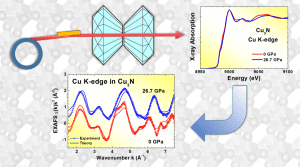Studies of structural phase transitions driven by pressure play an important role in materials science and geosciences. Nowadays, the availability of bright synchrotron radiation sources allows one to follow in-situ the structure-property relationships under extreme conditions.
In their in Physica Status Solidi B, researchers from Institute of Solid State Physics of the University of Latvia in collaboration with co-workers from SOLEIL synchrotron center (France), Stony Brook University (USA) and Ehime University (Japan) use energy-dispersive X-ray absorption spectroscopy to track how the crystal lattice of copper nitride (Cu3N) respondsto applied high pressure.
A membrane-type nano-polycrystalline diamond anvil cell, allowing improving the signal quality by eliminating spurious contributions from the Bragg reflections of diamonds, has been used to maintain the sample pressure in the range of 0–26.7 GPa.
Copper nitride is a semiconductor material with a band gap of 0.9–1.9 eV. It crystallizes at ambient pressure and temperature in anti-perovskite-type cubic crystal structure composed of corner-sharing NCu6 octahedra. The presence of an empty space between the octahedra and the low decomposition temperature of copper nitride indicate on the possibility of structure instability under high pressure. In fact, it is known that the material exhibits metallic conductivity, when is compressed above 5 GPa.
The analysis of the Cu K-edge X-ray absorption spectra based on the multiple-scattering theory suggests that the lattice parameter of copper nitride decreases upon the compression by about 2% at 26.7 GPa. At the same time, the cubic phase remains up to the highest studied pressure. Therefore, the transition to metal state in copper nitride is attributed solely to a continuous decrease and eventual collapse of the band gap.
The article is part of a special issue on “Synchrotron Radiation: Progress of Data Analysis, Data-Driven Science, and Theory for Science” guest-edited by Shinya Hosokawa.

















